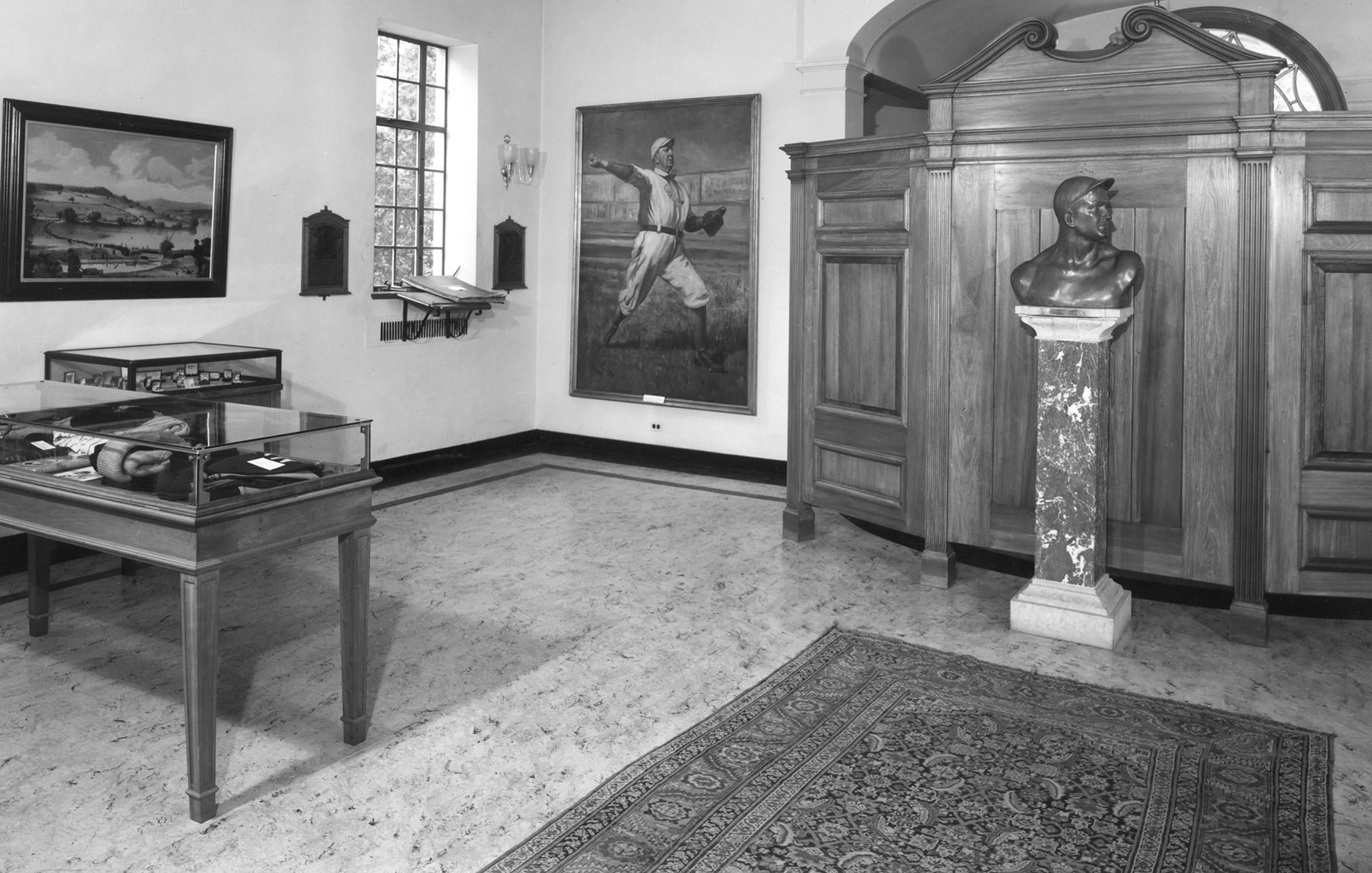
Museum History
BASEBALL BEGINNINGS
1905
The Mills Commission was established to determine the official origins of Baseball.
1908
The Mills Commission issued its final report, which stated that “the first scheme for playing baseball” was devised by Abner Doubleday at Cooperstown, NY in 1839.
1935
The “Doubleday baseball,” considered the first modern baseball, was discovered in a farmhouse near Cooperstown. With its stitched cover and cloth stuffing, the ball is a symbol of the legendary first baseball game of 1839 in Cooperstown, NY. Stephen C. Clark, a Cooperstown philanthropist, purchased the “Doubleday baseball” for $5 and created a one-room display of baseball objects in a local Cooperstown club that attracted wide attention.
THE NATIONAL BASEBALL HALL OF FAME AND MUSEUM
1936
The Hall of Fame was established and the first players to be inducted included: Ty Cobb, Walter Johnson, Christy Mathewson, Babe Ruth and Honus Wagner. Cobb earned the most votes.
1939
The National Baseball Hall of Fame and Museum opened in Cooperstown on June 12th, coinciding with Baseball’s centennial celebration. The Cooperstown Village Board of Trustees converted the pasture that was the legendary site of the original 1839 Doubleday ballgame to a full-fledged ballpark, named Doubleday field, which continues to be home to the annual Hall of Fame Game. By 1939, 25 players had been elected to the Hall of Fame; the 11 living Hall of Famers traveled to Cooperstown to celebrate Baseball’s centennial. The first commemorative Baseball stamp went on sale in the United States.
1950-1958
The Hall of Fame and Museum underwent tremendous expansion which included a new wing in 1950 and a plaque gallery in 1958.
1962
Jackie Robinson became the first African American elected to the Hall of Fame.
1963
The Hall of Fame received more than 2,000 pieces from the Mosler Collection, which is the institution's' largest accession to date.
1968
The National Baseball Library was established.
1971
Satchel Paige became the first Negro leaguer elected to the Hall of Fame.
1973
Roberto Clemente became the first Latin-born player elected to the Hall of Fame.
1989
The Cooperstown Museum celebrated its Golden Anniversary and the new Fetzer-Yawkey wing opened with the popular Grandstand Theater.
1994
An $8 million expansion to the Library was completed and a research facility was connected to the Museum.
1997
Pride and Passion: The African American Baseball Experience opened. The Museum's largest culturally important exhibition depicts the history of African Americans in Baseball from the time of the Civil War to present.
1998
The Museum opened The Great American Home Run Chase; an exhibition which featured bats used by record-breaking greats such as Babe Ruth, Roger Maris, Mark McGwire and Sammy Sosa.
1999
The Museum opened the Barry Halper Gallery, a rotating exhibition gallery. Named in honor of one of Baseball's greatest individual collectors, the gallery's first exhibit, Memories of a Lifetime: The Barry Halper Collection, featured 75 of the 200 relics acquired by the Museum. The collection of artifacts was donated to the Museum by Major League Baseball, which purchased them from Halper in 1998.
2001
The Museum welcomed its 12 millionth visitor this year; annual attendance averages 350,000.
2002
Baseball As America, the first major exhibition to examine the relationship between baseball and American culture, will premiere at the American Museum of Natural History on March 16, 2002 and subsequently traveled to nine leading museums across the U.S. The exhibit is extended and is currently at its final stop at the Museum of Science in Boston. The National Baseball Hall of Fame and Museum hosts first-ever Electronic Field Trip from Cooperstown. More than 20 million students participate in the one-day event, learning about baseball and Black History Month.
2003
The Museum embarked on a two-year renovation project to enhance exhibits; improve access for those with special needs; add appropriate technology; and upgrade preservation capabilities.
2008
The final Hall of Fame Game is rained out at Doubleday Field in Cooperstown. The game was an annual tradition begun in 1940. Major League Baseball had announced earlier in the year that it would be the last game due to scheduling difficulties.
2009
Hank Aaron: Chasing the Dream, a permanent exhibit chronicling Aaron’s life, from childhood through his big league career and post-baseball career, including his vast philanthropic efforts, is dedicated on April 25.
On Memorial Day Weekend, the Hall of Fame dedicated ¡Viva Baseball!, an exhibit devoted to baseball in the Caribbean Basin countries.
The Hall partners with the MLBPAA to create the Hall of Fame Classic. The first ever Classic, featuring Hall of Famers Bob Feller, Ferguson Jenkins, Paul Molitor, Phil Niekro, Brooks Robinson and more than 20 retired players, is played on June 21 at Doubleday Field in Cooperstown.
2013
On May 4, the Hall of Fame cut the ribbon on Diamond Mines, ushering in planned two-year exhibit dedicated to baseball scouts. The exhibit featured an online database of thousands of scouting reports.
2014
United States President Barack Obama becomes the first sitting President to visit the Hall of Fame on May 22.
2024
The Museum opened The Souls of the Game: Voices of Black Baseball.
2025
The Museum opened Getting the Nod, featuring highlights from the renowned collection of nearly 1,000 bobbleheads donated by Jeffrey H. Loria, and Yakyu | Baseball: The Transpacific Exchange of the Game, covering more than 1,800 square feet of space on the Museum’s third floor.
With the July 27 induction of Dick Allen, Dave Parker, CC Sabathia, Ichiro Suzuki and Billy Wagner, a total of 351 individuals have been inducted into the Hall of Fame, including 278 former major league players.
